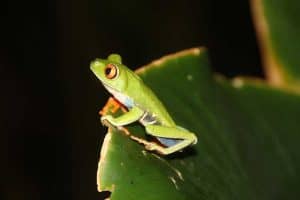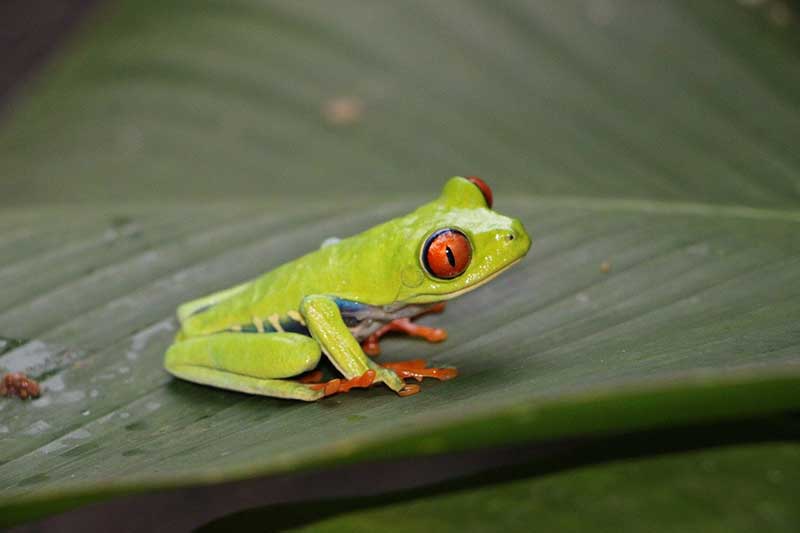Keeping amphibians can be a fulfilling and rewarding hobby. It is essential to know something about the natural habitat, feeding habits, and life cycle of any animal you are keeping. Amphibians are affected by the parameters of their environment, making it vital to keep them in a suitable space. Red-eyed tree frogs are a popular choice due to their distinctive and attractive colors.
In this article we’re going discuss proper housing for these amphibians, so let’s get right to it.
What Frogs Can Live in a 10 Gallon Tank?
Red-eyed tree frogs can comfortably live in a 10-gallon tank. The tank should be vertical as these frogs are arboreal and need to climb. They live in pairs or small groups, so a 10-gallon tank is enough space for a pair of red-eyed frogs. If you add another frog, you need to add another 5 gallons.

These fantastic little frogs are beautiful with their bulging red eyes, orange toes, and bright green bodies with blue and yellow sides. Any responsible pet owner wants to do the best for their pet, and it is critical to know how much space a red-eyed tree frog needs. Too little space could cause stress and failure to thrive. If you have a 10-gallon tank, would it be suitable for your red-eyed tree frog?
Red-eyed tree frogs have specific environmental needs. The owner needs to make their habitat as similar to their native habitat as possible.
What Is A Red-Eyed Tree Frog’s Natural Habitat?
Red-eyed tree frogs (Agalychnis callidryas) are found in Central and South American lowlands and on sloping hills near rivers. Their range can extend as far north as Mexico. They live in heavily forested areas with thick underground vegetation.
These nocturnal frogs have suckers on their feet that enable them to climb plants and trees. Adult red-eyed tree frogs may be found in the canopy layer of rainforests. Their intense green color helps them to hide inside plants such as the bromeliad. These frogs may be found on the underside of leaves, clinging to tree trunks or attached to branches.
Red-eyed tree frogs prefer lush green plants, which allow them to blend into the vegetation, creating a feeling of security. When they close their eyes, their eyelids are green, making them appear part of the plant. They tuck their bright-colored toes under them when they sleep during the day.
As with most frogs, red-eyed tree frogs start their lives as tadpoles in the water. They remain reliant on the presence of water and high humidity levels to keep their skin moist.
What Size Tank Does A Red-Eyed Frog Need In Captivity?
Amphibian owners are sometimes tempted to put red-eyed tree frogs into small enclosures because they are tiny frogs with a maximum adult size of two to three inches. This is a mistake as these little fogs need space to move around and climb. A small enclosure will result in a stressed frog that will not eat and may die.
A minimum size vivarium for a red-eyed frog is a 10-gallon tank. As these frogs prefer to live in pairs or small groups, you can put a pair of frogs into this size tank. If you aim to keep more than two frogs in a tank, you must add an extra five gallons of space for each frog.
It is important to remember that the vivarium must be a vertical tank to allow the frogs to climb to a considerable height. They become stressed when forced to live in a horizontal tank where there is no room for them to climb.

The frogs need space to hunt their food separately. Too many frogs in a small area may result in aggression during hunting. Smaller frogs may also not have the opportunity to catch the food as big frogs take over their space. Enough space is essential for these colorful amphibians.
It is crucial to have a snug-fitting lid on the vivarium as these small amphibian climbers will easily escape an unsecured tank.
What Habitat Does A Red-Eyed Tree Frog Need In Captivity?
The tank needs a substrate on the bottom that is capable of holding moisture. A cheap but not particularly attractive option is paper kitchen toweling. Other options such as orchid bark, sphagnum moss, or shredded coconut fiber mimic the forest floor.
Avoid gravelly substrates as red-eyed tree frogs have been known to accidentally ingest the small pieces while they are hunting. Swallowing foreign objects that cause impaction is one of the commonest causes for death or veterinarian visits in red-eyed tree frogs.
If you choose live plants for your vivarium, you will need a substrate that allows the plants to grow. Natural plants or artificial plants are a must in the red-eyed tree frog tank. Plants with broad leaves such as philodendrons and anthuriums are good choices.
Artificial plants can be used if you lack a green thumb. Choose artificial plants that resemble vines, broad-leafed plants, logs, and twigs. These plants must be firmly attached so that they do not fall over and lie in a heap on the bottom of the vivarium. It could also be dangerous for your frog to fall mid-climb.
Does A red-Eyed Tree Frog Need A Water Feature?
It is best for this frog to have access to a water feature of some kind. This does not have to be elaborate and can consist of a suitable shallow container that allows the frog to swim and soak. The container should have sloped sides so that the red-eyed frog can quickly exit the water.
The water should be kept clean as bacterial infections from dirty water can infect the frogs. Red-eyed tree frogs need a high level of humidity in their cages. A range of 60% – 70% humidity provides ideal humidity levels in the tank allowing the frogs to maintain essential moisture in their skin.
Conclusion
Red-eyed frogs are attractive pets to keep, although you may have to stay up at night if you want to watch these nocturnal amphibians in action. They are easy to maintain, provided you supply them with enough space, a vertical tank, and the proper humidity.



